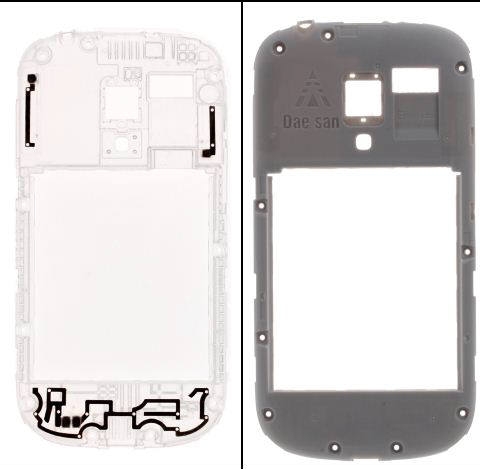Antenna market structure is shaking as smartphones with waterproof and dustproof functions are spreading.
This is because in-mold antenna (IMA) technology, which was pushed out from the mainstream following the advent of laser direct structuring (LDS) method, started drawing attention again as it is known to be advantageous in waterproof and dustproof smartphone implementation.
IMA makers are aiming to reclaim smartphone market by developing not only waterproof and dustproof functions, but also products of high-frequency (RF) performances and small thickness.
According to the industry on the 11th, IMA demand is increasing rapidly as waterproof and dustproof smartphones are winning popularity as of late.
Scheduled to launch ‘Galaxy S5,’ Samsung Electronics, especially, cancelled an order for five million LDS rear case built-in antennas and made a shift to IMA technology. The company adjusted its parts supply plan as the forwarding volume of Galaxy S5 Series’ waterproof and dustproof model increased from the initial plan.
In the past, waterproof and dustproof models were released in small numbers targeting a niche market. However, this function is forecast to position itself as a basic function for Samsung Electronics’ premium smartphone models.
LDS antenna is created by engraving patterns with laser on a plastic frame and plating the frame with silver or copper. It provides excellent RF function and is advantageous in creating smartphone with a small thickness. LDS antenna is currently applied to most high-end smartphones.
The problem is that LDS antenna has a weak waterproof function because it is difficult to completely seal the joints between main board (HDI) and antenna attached to the rear case. IMA has an advantage in terms of waterproof function because it is structurally convenient to fill up gaps in circuit joints.
This is a reason for the recent rise of Samsung Electro-Mechanics and RFTech, Samsung Electronics’ primary suppliers holding IMA technology. LG Electronics’ suppliers, such as LS Mtron, have also embarked on IMA technology development, according to sources.
However, IMA must solve a number of issues before it can be settled as a mainstream in smartphone market beyond the niche market centering on waterproof and dustproof functions. Compared to LDS antenna, IMA is lower in RF function and is disadvantageous in realizing a small thickness.
Some IMA makers are developing products as advanced as LDS antenna using thin-film injection molding technology. Using this technology, Daesan Electronics developed a ‘high-performance in-mold antenna (H-IMA)’ that surpasses performance and thickness level of LDS antenna. The double-injection thickness of H-IMA is more than half that of the existing IMA products. The thickness of plastic layer covering antenna is only around 0.15 ? 0.2mm. As a result, H-IMA produced RF performance greater than that of LDS antenna. When the antenna is inserted into a plastic case, the rear case of smartphone can be made thinner by 20% or more than the existing products. The key is whether or not the company can secure excellent mass-producibility.
“As press and injection molding technologies are gradually advancing, LDS antenna is facing a new challenge,” said an industry insider. “We are keeping our eyes on the antenna market, expecting yet another technological competition in the market.”
Lee Hyeong-soo | goldlion2@etnews.com
방수 스마트폰 확산…안테나 시장 구도 `흔들흔들`
<대산전자가 개발한 후면 케이스 일체형 안테나>
스마트폰에 방수?방진 기능이 확산되면서 안테나 시장 구도가 흔들리고 있다.
레이저다이렉트스트럭처링(LDS) 방식이 등장하며 비주류로 밀려난 인몰드안테나(IMA) 기술이 방수?방진 스마트폰 구현에 유리한 것으로 알려지면서 다시 주목받고 있기 때문이다.
IMA 제조 업체들은 방수?방진 기능뿐만 아니라 고주파(RF) 성능과 얇은 두께를 구현한 제품까지 개발해 스마트폰 시장 탈환을 노리고 있다.
11일 업계에 따르면 최근 방수?방진 스마트폰이 인기를 끌면서 IMA 수요가 빠른 속도로 늘고 있다.
특히 삼성전자는 `갤럭시S5` 출시를 앞두고 500만개의 LDS 후면 케이스 일체형 안테나 주문을 취소하고 IMA 방식으로 전환했다. 갤럭시S5 시리즈 방수?방진 모델 출하량이 당초 계획보다 늘면서 부품 수급 계획을 조정한 것으로 보인다.
종전까지 방수?방진 기능 모델은 틈새시장을 대상으로 소량 출시됐지만 앞으로는 삼성전자 프리미엄 스마트폰의 기본 성능으로 자리매김할 전망이다.
LDS 안테나는 플라스틱 위에 레이저로 패턴을 새기고 은?구리 등 금속을 도금하는 방식이다. RF 성능이 뛰어나고 얇은 스마트폰 두께를 구현하는 데도 유리하다. 현재 고가 스마트폰 대부분에 LDS 안테나가 쓰인다.
문제는 LDS 안테나가 방수 기능에 취약하다는 점이다. 후면 케이스에 부착된 안테나를 주기판(HDI)에 연결하는 접합부를 완전히 밀봉하기 어려운 탓이다. IMA는 구조적으로 회로 접합부 틈을 메우기 쉬워 방수 기능에 유리하다.
삼성전자 1차 협력사 중 IMA 기술을 보유한 삼성전기?RF텍이 최근 부상한 이유다. LS엠트론 등 LG전자 협력사도 IMA 기술 개발에 나선 것으로 알려졌다.
그러나 IMA가 방수방진 등 틈새시장을 넘어 스마트폰 시장에서 주류로 자리잡는 데는 풀어야할 숙제가 많다. IMA는 LDS 안테나에 비해 RF 성능이 떨어지고 얇은 두께를 구현하는 데도 불리하다.
일부 IMA 업체는 박막 사출 기술로 LDS 안테나 못지않은 제품을 개발하고 있다. 대산전자는 박막 사출 기술로 LDS 안테나의 성능과 두께를 넘어선 `고성능 인몰드안테나(H-IMA)`를 개발했다. H-IMA는 종전 IMA보다 이중 사출 두께를 절반 이상으로 얇게 구현한 제품이다. 안테나를 덮은 플라스틱 두께가 0.15~0.2㎜로 얇아 LDS 안테나보다 뛰어난 RF 성능을 구현했다. 플라스틱 케이스에 안테나를 삽입하면 스마트폰 후면 케이스를 종전보다 20% 이상 얇게 만들 수 있다. 관건은 양산성을 얼마나 확보하는지다.
업계 관계자는 “프레스?사출 기술이 점차 발달하면서 LDS 안테나도 새로운 도전에 직면했다”며 “안테나 시장에 또 한 번 기술 경쟁이 벌어질지 주시하고 있다”고 말했다.
이형수기자 | goldlion2@etnews.com
